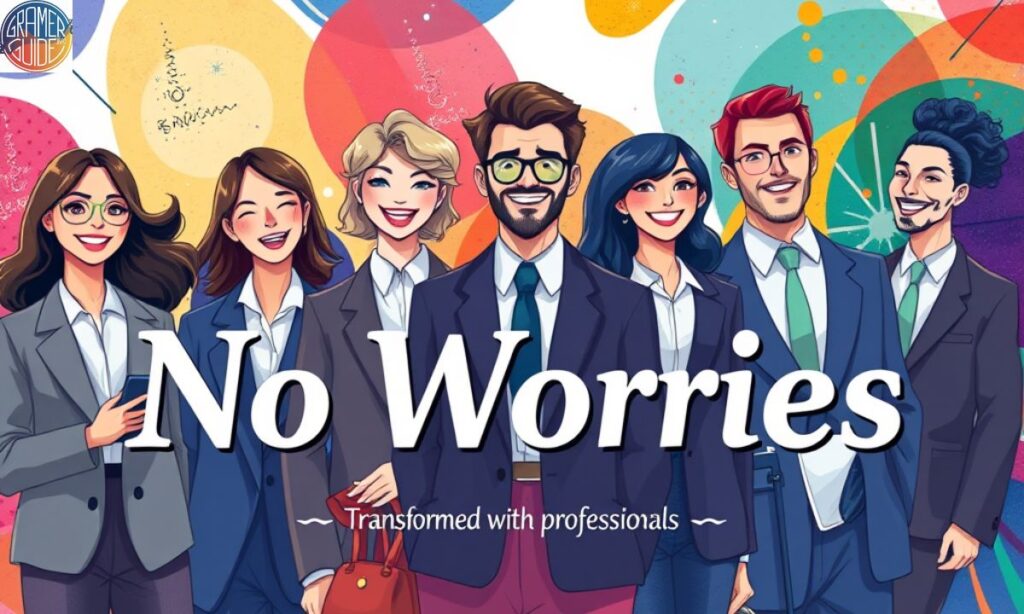In the professional world, how you communicate can make all the difference. The phrase “No Worries” is often too casual for many business settings. It’s important to replace it with more polished, professional alternatives that reflect respect and clarity.
With over 400+ expressions, you can choose the right words for any situation. This guide will help you find the perfect responses that maintain professionalism and enhance your communication skills.
Why Find Alternatives to “No Worries”?
In professional settings, language plays a crucial role in maintaining respectful communication. The phrase “No Worries” is often too casual for formal environments and can be perceived as unprofessional. Using alternatives ensures that your language reflects the seriousness of the conversation and maintains credibility.
Effective communication also involves tailoring your language to match the context. By replacing informal phrases with more formal expressions, you can improve your professional image. This helps you communicate confidently and respectfully.

No Problem
This is a versatile and widely used expression, often replacing “No Worries” when responding to inquiries or offering assistance.
- It’s not an issue at all.
- No trouble whatsoever.
- I’ve got it under control.
- It’s all taken care of.
- There’s nothing to be concerned about.
- Everything is manageable.
- It’s all good here.
- There is no concern.
- Not an issue, don’t worry.
- I’ve already sorted it out.
- No need for concern, I’ve got it.
- It’s all in hand.
Using “No Problem” makes the conversation more polished while conveying that the situation is well-handled without sounding too informal.
You’re Welcome
A classic response that shows grace and appreciation when someone thanks you. It’s a formal way to acknowledge the other person’s gratitude.
- It was a pleasure assisting you.
- Anytime, I’m happy to help.
- I’m glad I could be of assistance.
- It’s always my pleasure.
- You’re very welcome.
- I’m glad I could help.
- It was no trouble at all.
- I appreciate you saying that.
- Happy to be of service.
- Thank you for your kind words.
- I’m happy to support you.
- Always here to help.
This response is perfect when you want to maintain politeness while acknowledging your helpfulness.
My Pleasure
“My Pleasure” is a polite and slightly more formal response, showing that you genuinely enjoyed helping the other person.
- It’s truly my pleasure.
- I’m delighted to assist.
- It was great to help out.
- I’m happy to contribute.
- I’m pleased I could help.
- It’s always enjoyable to assist.
- I’m glad to help you.
- I’m grateful to be of assistance.
- It’s my privilege to help.
- Helping is always a joy for me.
- I’m pleased I could be of service.
- It’s an honor to assist.
This phrase is perfect when you want to show humility and satisfaction in helping others professionally.
Happy to Help
This phrase conveys a cheerful and professional tone. It expresses enthusiasm about offering assistance.
- I’m more than happy to assist.
- It’s great to help out.
- I’m thrilled to offer assistance.
- I’m always happy to lend a hand.
- It’s a pleasure to assist.
- Glad I could be of help.
- Happy to be of service.
- Pleased to support you.
- I’m here to assist whenever needed.
- It’s rewarding to help.
- I’m excited to contribute.
- Always willing to assist.
When you say “Happy to Help,” you add a layer of positivity and eagerness, which is great for maintaining good relationships in professional settings.
Absolutely
“Absolutely” is a firm, positive expression that shows you are fully committed and eager to help.
- Absolutely, I’m on it.
- Absolutely, I’ll take care of it.
- I’m absolutely certain I can assist.
- Absolutely, no concerns here.
- Absolutely, consider it done.
- No hesitation, absolutely.
- I’m absolutely happy to help.
- Absolutely, it’s all under control.
- Absolutely, leave it to me.
- Absolutely, I’ll handle it.
- Absolutely, you can count on me.
- Without a doubt, absolutely.
Using “Absolutely” gives your response a sense of decisiveness, showing your confidence and willingness to handle any task or request.
Of Course
This response is both polite and casual, and it reflects a confident willingness to help.
- Of course, I’m happy to assist.
- Of course, it’s no problem.
- Of course, leave it to me.
- Of course, it’s all taken care of.
- Of course, I’m on top of it.
- Of course, consider it done.
- Of course, I’m glad to help.
- Of course, feel free to ask.
- Of course, anytime you need me.
- Of course, I’ve already handled it.
- Of course, you can rely on me.
- Of course, everything’s in order.
“Of Course” is friendly and approachable, making it an excellent choice in professional settings that require a friendly yet formal tone.
No Trouble
This phrase implies that assisting or solving the issue is an easy task, showcasing a calm and confident approach to problem-solving.
- No trouble at all, happy to assist.
- No trouble, it’s completely fine.
- There’s no trouble here, it’s handled.
- No trouble whatsoever, I’ve got it.
- No trouble, consider it taken care of.
- No trouble on my end, no worries.
- It’s no trouble at all, I’m happy to help.
- No trouble, I’ll get it sorted for you.
- No trouble, don’t worry about it.
- No trouble, it’s nothing to stress over.
- No trouble, I’m here to support you.
- It’s no trouble, I’ve managed it.
“No Trouble” conveys a calm, professional attitude while reassuring the other party that things are under control.
It’s Fine
When you want to reassure someone that everything is okay and there is no need to worry, “It’s Fine” is a perfect response.
- It’s fine, everything’s in order.
- It’s completely fine, no need to worry.
- It’s fine, I’ve already dealt with it.
- It’s fine, there’s nothing to worry about.
- It’s perfectly fine, I’ve got it.
- It’s all fine, no issues here.
- It’s fine, I’ll make sure everything’s okay.
- It’s fine, I’ll sort it out.
- Everything’s fine, don’t stress.
- It’s fine, you don’t need to worry.
- It’s fine, all is well.
- It’s fine, I’ll take care of the details.
By using “It’s Fine,” you reassure others and create a sense of calm in the conversation.
Not a Problem
“Not a Problem” is a great way to assure someone that their concern is easy to manage and nothing to be worried about.
- Not a problem at all, I’ve got it.
- It’s really not a problem, everything’s good.
- Not a problem, I’ll get it done.
- Not a problem, consider it handled.
- It’s not a problem, I’m happy to help.
- Not a problem, I’ve already sorted it.
- Not a problem, leave it to me.
- Not a problem, I’m here for you.
- Not a problem, I’ll take care of it right away.
- Not a problem, I’ve got it under control.
- Not a problem, I’ve already managed it.
- Not a problem, everything is fine.
“Not a Problem” shows that the task or concern is minor and easily dealt with, creating a professional yet relaxed response.
Consider It Done
This expression gives a sense of professionalism and confidence, suggesting that the task will be completed without delay.
- Consider it done, I’ll take care of it.
- Consider it taken care of, no worries.
- Consider it sorted, it’s all under control.
- It’s done, I’ll handle everything.
- Consider it handled, I’ve already dealt with it.
- Consider it done, I’m on top of it.
- Everything’s covered, consider it finished.
- Consider it completed, I’ll manage the details.
- It’s done, you don’t need to worry about it.
- Consider it resolved, I’ve got it.
- I’ll consider it done, no more worries.
- It’s finished, you can trust me with it.
“Consider It Done” is a powerful and confident way to express that you’ve taken care of something or will do so immediately.
I’ve Got It Covered
This phrase reassures the other person that you are handling the situation and they need not worry. It’s a confident and professional way to show responsibility.
- I’ve taken care of everything on my end.
- Don’t worry about it; it’s all under control.
- Consider it done; I’m already on it.
- Everything’s in hand; no need for concern.
- I’ll manage it from here; you don’t need to do anything.
- Rest assured, I’ve got it all figured out.
- I’m already handling the situation.
- Everything is under control, and I’ve got it covered.
- You can trust that I’ll take care of it.
- I’ve got this; there’s nothing to worry about.
- I’ll make sure it gets done.
- I’ve handled it; you don’t need to worry.
Using “I’ve Got It Covered” establishes you as reliable and confident, making the other person feel comfortable and assured.
No Big Deal
This response helps minimize the importance of the situation, showing that it’s not a cause for concern and it’s easily manageable.
- It’s not a big deal; everything’s fine.
- No need to stress; it’s no big deal.
- It’s nothing serious; there’s no issue.
- Really, it’s no big deal at all.
- Nothing to worry about; it’s all good.
- There’s nothing to make a fuss over.
- Don’t stress, it’s not a big deal.
- It’s just a small thing; no big deal.
- No problem at all; it’s not a big deal.
- It’s really nothing to be concerned about.
- It’s all under control; it’s no big deal.
- I’ve got it covered, it’s not a big deal.
“No Big Deal” helps keep things light and shows that the situation is not worth overthinking, which can diffuse tension.
Anytime
“Anytime” is a versatile response that conveys availability and willingness to help at any time. It’s a great way to assure someone you’re there for them.
- I’m available anytime you need assistance.
- Feel free to reach out anytime.
- Don’t hesitate to contact me anytime.
- I’m happy to help anytime you need it.
- You can count on me anytime.
- Whenever you need, just let me know.
- I’m here to help anytime you need it.
- Anytime you have a question, I’m here.
- I’ll always be available for you anytime.
- You can reach out to me anytime, no problem.
- If you need anything, I’m here anytime.
- Anytime, I’m happy to assist you.
“Anytime” expresses a consistent willingness to help, making the other person feel supported and confident in reaching out to you whenever necessary.
Sure Thing
“Sure Thing” is an affirmative and casual response that demonstrates readiness and assurance without being too informal. It’s often used to show that you’re happy to assist.
- Sure thing, I’ll take care of it.
- No problem at all, sure thing.
- Sure thing, I’ve got it covered.
- Absolutely, sure thing.
- Consider it done, sure thing.
- Sure thing, I’m already on it.
- You can count on me, sure thing.
- Sure thing, I’ll make sure it’s done.
- It’s all good, sure thing.
- No worries, sure thing.
- Sure thing, everything’s under control.
- You don’t have to worry, sure thing.
This phrase is polite and professional while maintaining a confident, can-do attitude.
Don’t Mention It
This expression is often used after someone thanks you, signaling that the help you provided was no trouble at all and not something to be acknowledged.
- Don’t mention it, it was no trouble.
- No need to mention it, I’m happy to assist.
- It was nothing, don’t mention it.
- It’s not worth mentioning; I’m happy to help.
- Don’t mention it, it’s all part of the job.
- You’re welcome, don’t mention it.
- No need to thank me; don’t mention it.
- It’s no trouble at all, don’t mention it.
- Glad to help, don’t mention it.
- Don’t worry about it, it’s nothing to mention.
- I’m happy to help, don’t mention it.
- Don’t mention it, it was easy to do.
“Don’t Mention It” conveys humility, indicating that you were happy to help and don’t expect gratitude.
It’s No Trouble
This phrase emphasizes that assisting or solving the issue is easy and nothing to be concerned about. It conveys an attitude of calmness and helpfulness.
- It’s no trouble at all; I’m happy to assist.
- No trouble, I’ve got it covered.
- Don’t worry about it, it’s no trouble.
- It’s really no trouble, leave it to me.
- No trouble here, I’ll handle it.
- It’s no trouble, I’ll take care of everything.
- No trouble, it’s all in hand.
- You’re welcome; it’s no trouble at all.
- It’s no trouble, everything’s under control.
- No trouble, I’ve already taken care of it.
- It’s no trouble, everything is sorted.
- It’s no trouble, I’ll manage it.
By saying “It’s No Trouble,” you reassure the other person that there is no inconvenience in helping them out.
No Worries at All
This expression is similar to “No Worries,” but with a more definitive tone, reinforcing that everything is perfectly fine and no issues exist.
- No worries at all, I’ve got it covered.
- Don’t stress, no worries at all.
- It’s all handled, no worries at all.
- No worries at all, everything is under control.
- Don’t worry, no worries at all here.
- I’ve got it covered, no worries at all.
- It’s no issue, no worries at all.
- No worries at all, I’m happy to help.
- All is well, no worries at all.
- You don’t need to worry, no worries at all.
- No worries at all, everything’s fine.
- It’s all sorted, no worries at all.
“No Worries at All” ensures the other person knows there is no cause for concern, and you’ve already taken care of things.
No Need to Worry
This phrase provides assurance that the situation is under control and there’s no need for the other person to feel anxious or concerned.
- There’s no need to worry; I’ve handled it.
- No need to worry; everything is fine.
- Don’t worry about it, no need to worry.
- It’s already under control; no need to worry.
- You don’t have to worry, I’ve got it covered.
- No need to worry, I’m on top of it.
- There’s no cause for concern, no need to worry.
- It’s all sorted out, no need to worry.
- No need to worry, I’ll manage it.
- No need to stress, it’s all handled.
- Don’t worry about anything, no need to worry.
- I’ve got it all under control, no need to worry.
“No Need to Worry” is a comforting phrase that tells the other person that there is nothing to be concerned about and you are taking care of everything.
I’m Here to Help
This is a reassuring statement that lets the other person know you are ready and available to offer assistance when needed.
- I’m here to help anytime.
- You can always count on me; I’m here to help.
- I’m here to assist you whenever needed.
- Feel free to reach out, I’m here to help.
- I’m here to support you, don’t hesitate.
- If you need anything, I’m here to help.
- I’m available to assist you anytime.
- I’m here to help make things easier.
- You don’t have to do it alone, I’m here to help.
- I’m always here for you, let me know.
- I’m here to assist with anything you need.
- Just let me know how I can help, I’m here.
“I’m Here to Help” shows your willingness to be supportive, ensuring the other person feels confident in asking for assistance.
It’s All Taken Care Of
This phrase conveys that everything is under control and no further action is needed. It reassures the other person that there’s no need to worry about the matter anymore.
- It’s all taken care of, no need for concern.
- Everything is handled, it’s all taken care of.
- I’ve got it covered; it’s all taken care of.
- It’s all sorted out, don’t worry.
- All tasks are complete, it’s all taken care of.
- It’s all in hand; everything’s taken care of.
- No need to follow up, it’s all taken care of.
- It’s all resolved; you don’t need to do anything.
- Everything’s under control; it’s all taken care of.
- Don’t worry, it’s all handled.
- Everything’s set, it’s all taken care of.
- Consider it done, it’s all taken care of.
By saying “It’s All Taken Care Of,” you leave no room for doubt, ensuring that the matter is resolved completely.
Cross-Cultural Communication
In cross-cultural communication, what may seem like a friendly, casual phrase in one culture can be seen as dismissive in another. It’s crucial to understand the nuances of language and adapt to different cultural expectations.
Using universally accepted and professional language helps avoid misunderstandings. This approach creates a more respectful, inclusive environment for everyone involved in the conversation.
Tone and Delivery
The tone of your response significantly affects how your message is received. Casual phrases like “No Worries” may come off as too informal or even dismissive, especially when tone isn’t conveyed clearly.
By opting for more professional alternatives, you ensure that your delivery remains respectful and appropriate for the situation. This creates a balanced, positive atmosphere for communication.
Common Mistakes to Avoid
One common mistake is overusing casual phrases, which can diminish your professionalism. Instead, it’s important to choose language that aligns with the context, showing respect and credibility.
Another mistake is failing to adjust your tone based on the situation. Understanding when to switch from casual to formal language helps you avoid sounding too informal or disrespectful.
FAQ’s
Why should I avoid using “No Worries” in professional settings?
“No Worries” can sound too casual, which may undermine your professionalism. It’s best to choose more formal alternatives.
Can these professional alternatives be used in all work environments?
Yes, these alternatives can be tailored to fit formal and informal work environments, ensuring you always sound respectful.
How can I ensure I am being respectful in my responses?
By using professional and polite expressions, you show respect and consideration for the person you’re communicating with.
Are there alternatives for every situation?
Yes, there are professional expressions for various situations, from offering help to addressing concerns.
How can these alternatives improve my workplace communication?
Using more professional expressions can help you build credibility, trust, and stronger relationships in the workplace.
Conclusion
Replacing “No Worries” with professional alternatives helps maintain the right tone in any conversation. With over 400+ expressions, you can ensure that your communication is always clear, respectful, and effective.

I’m Hayyat, a passionate content writer and SEO expert with 5 years of experience. I specialize in creating engaging content and optimizing it for search engines.





